Instructions for creating UEFI standard USB boot using Rufus software
UEFI or Legacy, MBR or GPT is always something that confuses many people during the process of creating a USB to install Windows. That's why the Rufus tool was born to help you create a UEFI standard USB boot using Rufus or Legacy without having to worry about what it is because your goal of creating a Windows installation USB has definitely been achieved. How to use Rufus is very simple, this tool is quite compact and TipsMake is sure that you only need to spend 1 minute reading the instructions below to master Rufus.
Instructions for creating UEFI standard USB boot using Rufus
Preparation:
- A USB with a minimum capacity of 8 GB.
- Rufus USB boot creation software, download Rufus here.

Step 1: After downloading Rufus according to the instructions above, to create a standard UEFI USB boot with Rufus, we must open this software first by right-clicking > selecting Run as administrator .

Step 2: The Rufus interface appears, here you just need to click Select to select the ISO file to be able to create a UEFI standard USB boot with Rufus.

Here we just need to choose any ISO file, you can download these ISO files on TipsMake depending on whether you want to use USB to install Windows 7, 8 or Windows 10.

Step 3: After selecting, the system will default to Partition scheme as GPT and Target system as UEFI . Our remaining task is just to press Start.
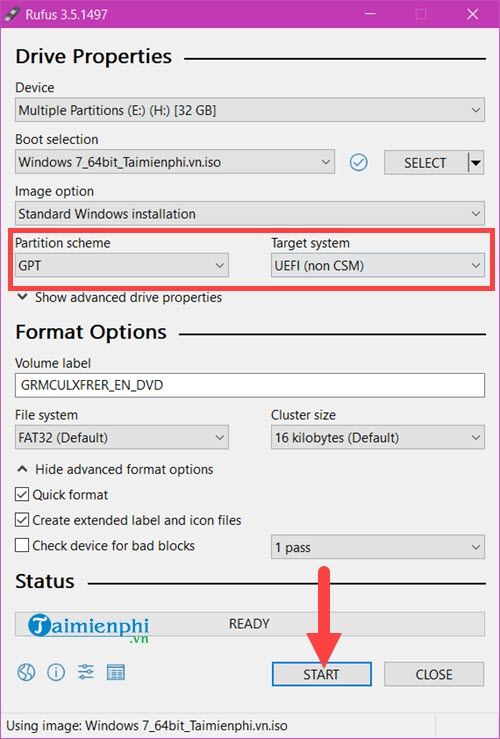
Step 4: The system will ask to reformat the USB, of course all data inside will be completely erased, so we need to copy the data if there is data to retrieve.
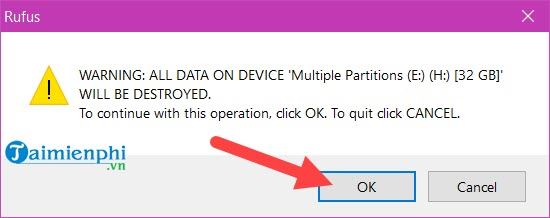
In addition, Rufus also warns that if you divide your USB into multiple partitions, it will also be merged into one.
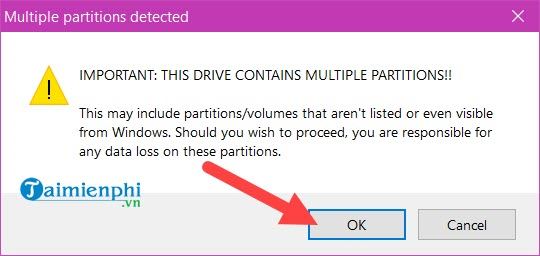
Step 5: The process of creating a UEFI standard USB boot with Rufus does not take long, because it only takes time to copy the ISO file from the computer to the device.
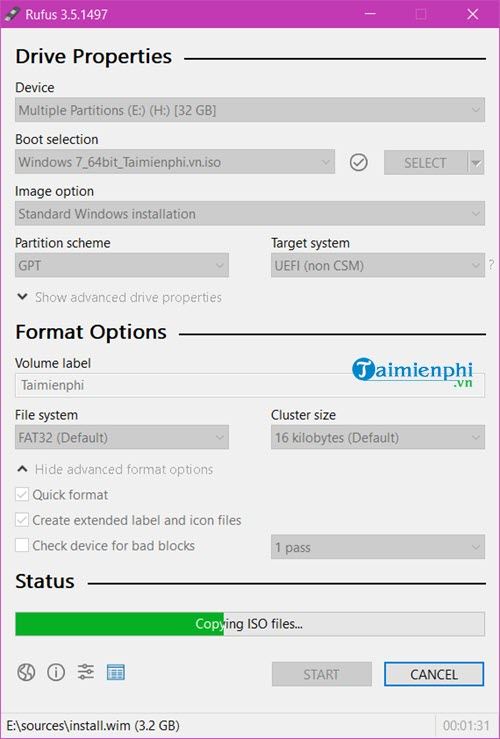
Step 6: When Rufus announces Ready, creating a UEFI standard USB boot with Rufus has been completed. Click Close, remove the USB, plug it into the computer where Windows needs to be installed and install Windows as usual.
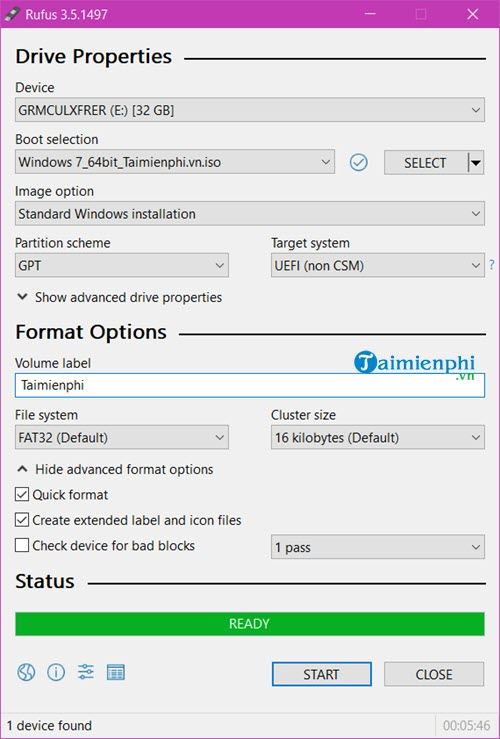
After creation, we can install Windows. Refer to 2 more articles on how to install Windows 7 and Windows 10 if you do not know how to install.
So with just a few basic steps we can create a standard UEFI USB boot with Rufus. In addition, TipsMake also believes that if you are planning to create a Windows 10 USB Boot or any operating system, choosing to create USB Boot Win 10 with Rufus is the most reasonable choice.
You should read it
- How to create Windows 10 installation USB using Rufus, Boot UEFI and LEGACY
- How to Use Rufus
- Instructions for creating Windows installation USB on both GPT and MBR standards with Rufus
- How to create USB Boot, create a Windows installation USB with Rufus is simple and effective
- How to create USB Boot, USB install Windows by Rufus
- How to create UEFI standard USB BOOT - GPT containing the Win 7/8 / 10 installer
- Common errors when using Rufus and the simplest and most effective ways to fix them
- It is possible to create a USB to install Windows 11 on an unsupported machine with Rufus
May be interested
- Steps to create USB Boot using Command Prompt
 creating usb boot with command prompt is quite complicated and has many commands to remember compared to how to create usb boot with rufus software. if you want to try to improve the level of creating usb boot with cmd, please follow the instructions in the following article.
creating usb boot with command prompt is quite complicated and has many commands to remember compared to how to create usb boot with rufus software. if you want to try to improve the level of creating usb boot with cmd, please follow the instructions in the following article. - How to create USB Boot to install Windows 10 with Rufus
 creating a usb boot to install windows 10 with rufus is one of the simplest and most effective ways used by many people. however, if you do not know how to create a usb boot to install windows 10 with rufus, the article below tipsmake will guide you to do so. you can also apply it to creating a usb to install windows 11.
creating a usb boot to install windows 10 with rufus is one of the simplest and most effective ways used by many people. however, if you do not know how to create a usb boot to install windows 10 with rufus, the article below tipsmake will guide you to do so. you can also apply it to creating a usb to install windows 11. - Concept of UEFI standard in computers
 uefi (unified extensible firmware interface) was developed by intel to address the weaknesses of the bios as well as replace the old and aging bios standard. of course it will be much more powerful than the bios and is really useful for things like overclocking.
uefi (unified extensible firmware interface) was developed by intel to address the weaknesses of the bios as well as replace the old and aging bios standard. of course it will be much more powerful than the bios and is really useful for things like overclocking. - 20 best USB boot software
 20 this usb boot software will help you create usb boot, usb install win quickly, easily, even can create usb boot containing many operating systems.
20 this usb boot software will help you create usb boot, usb install win quickly, easily, even can create usb boot containing many operating systems. - How to create and extract Ghost in UEFI standard and standard GPT hard drive
 for newer computers, high configuration using windows 64 bit, we must use the windows installation, ghost supports uefi - gpt standard. if you do not know how to extract the standard uefi - gpt ghost, you should follow the instructions below.
for newer computers, high configuration using windows 64 bit, we must use the windows installation, ghost supports uefi - gpt standard. if you do not know how to extract the standard uefi - gpt ghost, you should follow the instructions below. - How to create USB Boot, create a Windows installation USB with Rufus is simple and effective
 with instructions on how to create usb boot, create usb to install windows for laptop through rufus software simple and effective with detailed steps, notes before implementation.
with instructions on how to create usb boot, create usb to install windows for laptop through rufus software simple and effective with detailed steps, notes before implementation. - How to create a standard USB BOOT to install Windows 10 on both UEFI and LEGACY
 how to create a usb to install windows 10 is an important step in installing a new operating system. with tools like rufus or microsoft's media creation tool, users can easily create a usb boot containing the windows 10 installer. this process helps install the windows 10 operating system on multiple devices conveniently and quickly. fast.
how to create a usb to install windows 10 is an important step in installing a new operating system. with tools like rufus or microsoft's media creation tool, users can easily create a usb boot containing the windows 10 installer. this process helps install the windows 10 operating system on multiple devices conveniently and quickly. fast. - How to enable / disable Fast Boot in UEFI firmware settings on Windows
 the fast boot feature for uefi motherboards has a fast and ultra fast option that allows your pc to boot much faster than normal.
the fast boot feature for uefi motherboards has a fast and ultra fast option that allows your pc to boot much faster than normal. - How to disable / enable UEFI Secure Boot in Windows 10
 disabling uefi secure boot mode in windows 10 may be necessary to activate the graphics card or to boot the pc with an unrecognizable usb or cd.
disabling uefi secure boot mode in windows 10 may be necessary to activate the graphics card or to boot the pc with an unrecognizable usb or cd. - How to check and access UEFI settings on Windows 10
 if you want to access uefi firmware settings to change the default boot order or set password uifi, you do not know how to do it. you can refer to the steps taken to access uefi settings in the following article of network administration.
if you want to access uefi firmware settings to change the default boot order or set password uifi, you do not know how to do it. you can refer to the steps taken to access uefi settings in the following article of network administration.










 Instructions for creating Windows installation USB on both GPT and MBR standards with Rufus
Instructions for creating Windows installation USB on both GPT and MBR standards with Rufus How to ghost Windows 7, ghost Windows 7 using Hiren Boot's CD
How to ghost Windows 7, ghost Windows 7 using Hiren Boot's CD How to create a USB to install Windows using Windows 7 USB Download Tool
How to create a USB to install Windows using Windows 7 USB Download Tool How to create a bootable USB without Format using EasyBCD
How to create a bootable USB without Format using EasyBCD How to ghost Windows 10 using Onkey, USB, Norton ghost without a disk
How to ghost Windows 10 using Onkey, USB, Norton ghost without a disk Instructions for deleting the copyright request notice on the right corner of the Windows 10 screen
Instructions for deleting the copyright request notice on the right corner of the Windows 10 screen